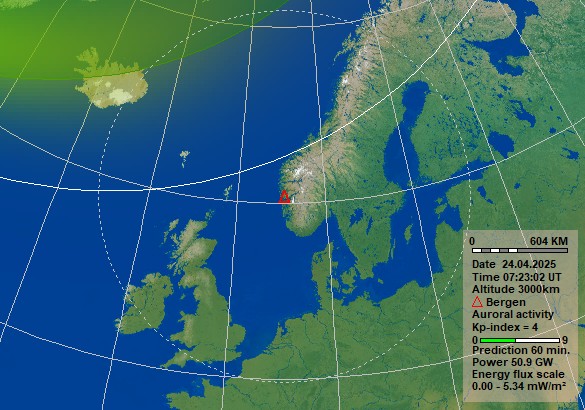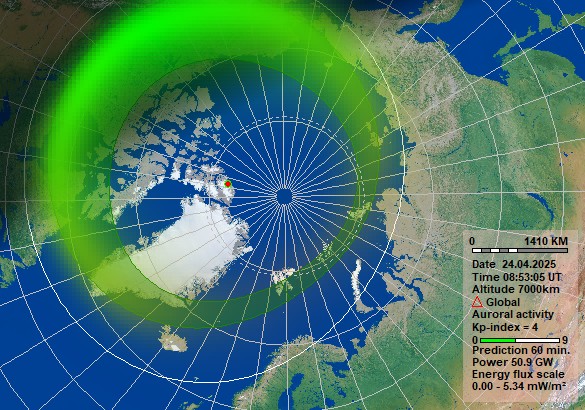Data is retrieved from NOAA and updates every 5. minutes.
How to read the northern lights forecast in an easy way
To understand the northern lights forecast, you need to know a bit about what the KP and Bz values mean. The KP value provides information about how far south the northern lights are visible. Imagine an oval centered over the North Pole, and this oval represents the northern lights. The higher the KP value, the wider the oval, and the farther south the northern lights can be observed. The exact southern limit is determined by latitude. On this page, you’ll find a table that makes it easy for you to determine the minimum KP required to see the northern lights from where you live.
The Bz value tells us the direction of the interplanetary magnetic field and how solar particles react with our atmosphere. In practice, we can use this to say something about the strength of the northern lights. If Bz has a negative value, it positively influences the northern lights. The more negative it is, the stronger the northern lights become. If it is strongly positive, the northern lights weaken, and it may not be possible to see northern lights at all.
In summary, a high KP in combination with a negative Bz is good for the northern lights. We have summarized the northern lights forecast in text format to make it easier to understand. Note that the information at the top of the page is the freshest available. The time from measurement to atmospheric impact and the creation of northern lights varies between 15-60 minutes depending on the speed of the solar wind. The northern lights are ephemeral, and the forecast is not always entirely accurate.
The best northern lights forecast we have is our own eyes. If you see the northern lights, please report when and where in the Facebook group so that more people can be made aware of the activity. Together we are strong!
Northern lights forecast for the next three days
This is the expected KP index for today and the following days. The table displays Norwegian time, and the information is updated daily.
| Time | 22. OCT | 23. OCT | 24. OCT |
|---|---|---|---|
| 01:00-04:00 | 4.33 | 2.67 | 2.67 |
| 04:00-07:00 | 2.67 | 2.67 | 2.33 |
| 07:00-10:00 | 2.67 | 2.33 | 2.00 |
| 10:00-13:00 | 2.67 | 2.33 | 2.00 |
| 13:00-16:00 | 2.67 | 2.33 | 2.00 |
| 16:00-19:00 | 2.67 | 2.33 | 2.00 |
| 19:00-22:00 | 2.67 | 2.33 | 2.00 |
| 22:00-01:00 | 2.67 | 2.00 | 2.00 |
The northern lights in one hour
Graphics showing the expected northern lights one hour ahead in time. These are obtained from NOSWE and are created using software and data from KHO.


The northern lights in four hours
Graphics showing the expected northern lights four hours ahead in time. These are obtained from NOSWE and are created using software and data from KHO.


Thank you for choosing nordlysvarsel.com
Our website started as a hobby project aimed at simplifying Northern Lights alerts. The response has been overwhelmingly positive, and we’re excited to witness the growing community of Northern Lights enthusiasts who use our site daily. Although we’re not experts, we’re constantly learning alongside our users. We collect Northern Lights forecasts from external sources and endeavor to present them in the most user-friendly manner. While we diligently quality-check our sources, occasional errors may still occur. All other information is based on our firsthand experience.
We highly value feedback and welcome suggestions for improving the website. If you come across any inaccuracies or have ideas for enhancements, please don’t hesitate to contact us via Messenger. Additionally, our Facebook group provides a platform for sharing and asking questions, with members who are eager to assist.
